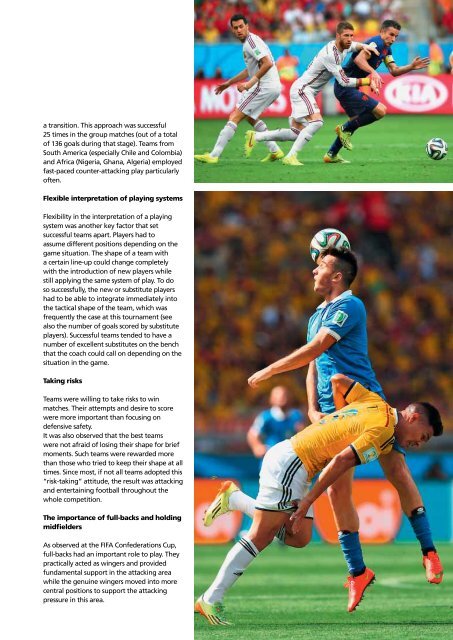2014fwc_tsg_report_15082014_neutral
2014fwc_tsg_report_15082014_neutral
2014fwc_tsg_report_15082014_neutral
You also want an ePaper? Increase the reach of your titles
YUMPU automatically turns print PDFs into web optimized ePapers that Google loves.
Trends 63<br />
a transition. This approach was successful<br />
25 times in the group matches (out of a total<br />
of 136 goals during that stage). Teams from<br />
South America (especially Chile and Colombia)<br />
and Africa (Nigeria, Ghana, Algeria) employed<br />
fast-paced counter-attacking play particularly<br />
often.<br />
Flexible interpretation of playing systems<br />
Flexibility in the interpretation of a playing<br />
system was another key factor that set<br />
successful teams apart. Players had to<br />
assume different positions depending on the<br />
game situation. The shape of a team with<br />
a certain line-up could change completely<br />
with the introduction of new players while<br />
still applying the same system of play. To do<br />
so successfully, the new or substitute players<br />
had to be able to integrate immediately into<br />
the tactical shape of the team, which was<br />
frequently the case at this tournament (see<br />
also the number of goals scored by substitute<br />
players). Successful teams tended to have a<br />
number of excellent substitutes on the bench<br />
that the coach could call on depending on the<br />
situation in the game.<br />
Taking risks<br />
Teams were willing to take risks to win<br />
matches. Their attempts and desire to score<br />
were more important than focusing on<br />
defensive safety.<br />
It was also observed that the best teams<br />
were not afraid of losing their shape for brief<br />
moments. Such teams were rewarded more<br />
than those who tried to keep their shape at all<br />
times. Since most, if not all teams adopted this<br />
“risk-taking” attitude, the result was attacking<br />
and entertaining football throughout the<br />
whole competition.<br />
The importance of full-backs and holding<br />
midfielders<br />
As observed at the FIFA Confederations Cup,<br />
full-backs had an important role to play. They<br />
practically acted as wingers and provided<br />
fundamental support in the attacking area<br />
while the genuine wingers moved into more<br />
central positions to support the attacking<br />
pressure in this area.


